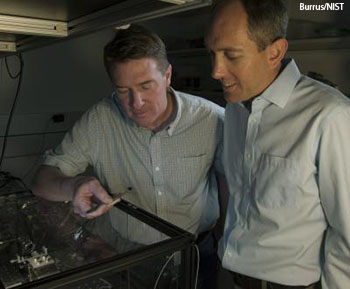
NIST physicists Scott Diddams (left) and Scott Papp with a prototype atomic clock based on a chip-scale frequency comb.
Researchers from the U.S. National Institute of Standards and Technology (NIST) and the California Institute of Technology (Caltech), U.S.A., have developed a microresonator frequency comb optical clock that they believe could help take precision frequency metrology out of the lab and into the real world (Optica, DOI: 10.1364/OPTICA.1.000010). According to the team, this is the first demonstration of all-optical control of the microcomb—the “gears” of the clock—and its accurate conversion of optical frequencies to lower, measurable microwave frequencies. The new silicon-chip-based clock could be used to create portable precision frequency metrology tools for telecommunications systems or signals to boost stability and resolution in radar, navigation and scientific instruments.
Optical clocks are unbeatable time-keepers because they rely on narrow, dependable atomic transitions to create stable laser frequencies measured at better than 10-17 stability. Optical frequency combs, or microcombs, measure these atomic transitions by providing a set of reference lines—the “teeth” of the comb. NIST and Caltech researchers generated a microcomb spectrum with a 25 THz span by exciting a 2-mm-wide silica disk with a continuous-wave laser and broadened the spectrum using nonlinear fiber. The spectrum was stabilized to two energy transitions in rubidium atoms—frequency references separated by 3.5 THz, controlled by microcomb lines 108 modes apart. The comb converted the output, or “ticks,” from the optical clock into electronically countable 33 GHz microcomb line spacing.
The microcomb chips can be made using common fabrication techniques; therefore, it should be easy to mass produce and incorporate them into existing chip-scale components, e.g., lasers and atomic references. The researchers hope the optical clock could be one of many components on a NIST chip that would offer several different measurement methods and standards on a portable platform. Next, the authors hope to fully determine the clock’s precision and reduce the prototype’s table-sized rubidium reference.
